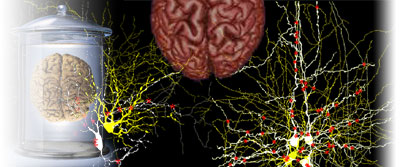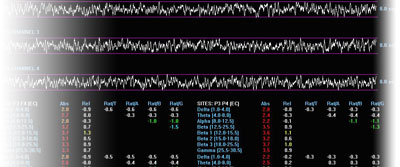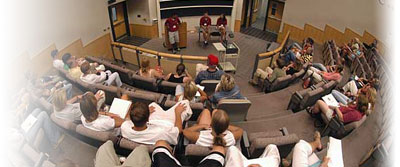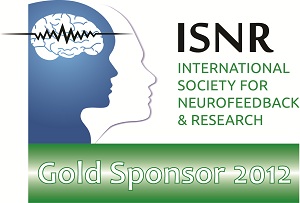
The patient needs more help than medications and psychotherapy can offer.

Most experienced clinicians are well aware of the limitations of medications and psychotherapy. But what are their options?
Neurofeedback, also known as neurotherapy is not strange, and it’s not new. Few clinicians are aware of neurotherapy and how far it has advanced. Once they hear about it and start to look into it further, they will often say that it made sense to offer it to their clients. That’s true for even very conservative professionals. They just have to be willing to jump in. Most clinicians who adopt neurotherapy already have 15 to 20 years or more of experience. It’s clearly not the young clinicians who pick it up first. It seems experienced clinicians are more acutely aware of the limits of medications and psychotherapy


Clients are demanding an alternative to medications.
Doctors and parents are often concerned about the side effects and long-term consequences that medications have on children. Parents and patients push for alternatives that work. When they learn about neurotherapy, they’re often more open and interested initially than many clinicians.

It makes sense to self-regulate the brain.

Many clinicians claim that the idea that you can train the brain and improve self-regulation through neurotherapy simply makes sense. So how does a clinician help the client change the brain? Meditation, yoga, or deep breathing sometimes help. But many of the problems patients bring need supplemental interventions. Neurotherapy helps an individual learn to regulate their brain by increasing certain activity and decreasing other activity.

The neurophysiology is compelling.
Some clinicians are unconvinced or very cautious as they look into neurotherapy. However, once they attend a very good course that makes the neurophysiology understandable, it can be an “a-ha” moment. (Note – this isn’t simple stuff and it takes some effort to get it). When someone changes their EEG you are by definition changing activation and timing patterns. These affect many pathways and feedback loops in the brain. When you start to understand such mechanisms, neurotherapy becomes more compelling.

Symptoms improve quickly.

Seeing someone experience a change rapidly that cannot be explained any other way never fails to amaze. The brain can shift states very quickly. As an example, in many training courses we’ve observed, by the end of several days of training, 80+% of attendees have noticed clear, significant changes in state. Changes influence sleep, mood, alertness, or attention. For some clients, changes – often quite unexpected changes – occur in minutes. Experienced clinicians quickly note these unexpected changes cannot be placebo, and can only be explained by the training. NOTE: Ten or more training sessions, depending on the severity of the client’s condition, are needed before any short-term transitory changes can be expected to hold.


The research is impressive.
Though the “lack of research” or its limitations are often cited, that’s usually from people who haven’t read much of it. When clinicians read enough of the research and look at some outcome studies, particularly with ADD, depression anxiety, and addictions, it’s very hard to dismiss. Neurofeedback is evidence-based. The size of the clinical effect is impressive, compared, for example, to the minimal effects you see in many studies on medications.

Other clinicians recommend neurotherapy.
Clinicians will often look into neurotherapy after hearing another clinician talk about its success and impact. Providers who are experienced in neurofeedback can offer some excellent clinical insights.

Family, friend, or patient who has experienced neurotherapy recommend it.

Many clinicians enter this field because someone they have personally met has experienced a success that was simply too life-changing to dismiss. It could be chronic depression that’s no longer chronic. Or perhaps a very out-of-control child who has settled down and is making great grades. But what’s especially compelling about neurotherapy successes is that the changes tend to sustain over time. How many alternative treatments see changes sustain two, four, or five years later?
Copy adapted from and used with permission by www.aboutneuroffedback.com






 Thomas Collura
Thomas Collura David Cantor
David Cantor Robert (Rusty) Turner
Robert (Rusty) Turner Richard McAlister
Richard McAlister David Ims
David Ims Jeff Reich
Jeff Reich Steve Warner
Steve Warner Thomas Brownback
Thomas Brownback Dolores Gaxiola
Dolores Gaxiola J. Michael Griffin
J. Michael Griffin Donna Creasy
Donna Creasy McGill Scott
McGill Scott Rich Davis
Rich Davis Harry (Bill) Brubaker
Harry (Bill) Brubaker Andre Keizer
Andre Keizer Penijean Gracefire
Penijean Gracefire John Demos
John Demos Mark Smith
Mark Smith Dick Genardi
Dick Genardi Jeff Tarrant
Jeff Tarrant Adrian Roel
Adrian Roel Thomas Feiner
Thomas Feiner Joseph Guan -Tech
Joseph Guan -Tech Bill Mrklas
Bill Mrklas Christen Stahl
Christen Stahl Giuseppe Chiarenza
Giuseppe Chiarenza Yvonne Tate
Yvonne Tate Lisa Black
Lisa Black Doron Todder
Doron Todder Dayna Nevar
Dayna Nevar Becky Bassham
Becky Bassham Michael Trayford
Michael Trayford Ron Bonstetter
Ron Bonstetter



